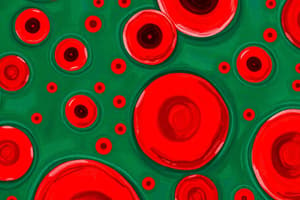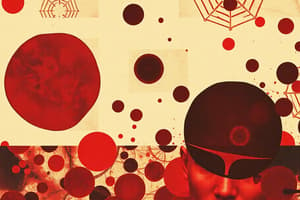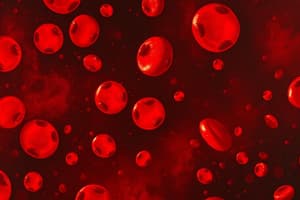Podcast
Questions and Answers
Which of the following is the primary role of erythrocytes?
Which of the following is the primary role of erythrocytes?
- Fighting infections through phagocytosis
- Regulating allergic reactions through histamine release
- Transporting oxygen via hemoglobin (correct)
- Initiating blood clotting through thrombopoiesis
What condition arises from excess red blood cells?
What condition arises from excess red blood cells?
- Thrombocytopenia
- Anemia
- Leukopenia
- Polycythemia (correct)
How does carbon monoxide (CO) impact the oxygen-carrying capacity of blood?
How does carbon monoxide (CO) impact the oxygen-carrying capacity of blood?
- CO has a lower affinity for hemoglobin than oxygen, posing no threat.
- CO decreases the affinity of hemoglobin for oxygen, improving tissue oxygenation.
- CO has a higher affinity for hemoglobin than oxygen, thus reducing oxygen binding. (correct)
- CO increases the production of red blood cells, compensating for oxygen deficiency.
Which type of leukocyte is most abundant and acts as a primary defender against bacterial infections?
Which type of leukocyte is most abundant and acts as a primary defender against bacterial infections?
What is the role of erythropoietin in regulating blood cell production?
What is the role of erythropoietin in regulating blood cell production?
Which of the following best describes the role of basophils in the immune response?
Which of the following best describes the role of basophils in the immune response?
Which of the following blood types has both A and B antigens on the surface of their red blood cells?
Which of the following blood types has both A and B antigens on the surface of their red blood cells?
A patient with a thrombus in a major artery is at risk of developing what condition?
A patient with a thrombus in a major artery is at risk of developing what condition?
Why is erythroblastosis fetalis a concern in Rh-negative pregnant women?
Why is erythroblastosis fetalis a concern in Rh-negative pregnant women?
In hemostasis, what is the immediate response to blood vessel injury?
In hemostasis, what is the immediate response to blood vessel injury?
Flashcards
Blood Functions
Blood Functions
Distributes substances, regulates levels, and protects the body.
Blood Plasma
Blood Plasma
Mostly water with albumins, globulins, clotting proteins, electrolytes, nutrients, wastes, hormones and gasses.
Erythrocytes
Erythrocytes
Red blood cells that carry oxygen using hemoglobin.
Hematocrit
Hematocrit
Signup and view all the flashcards
Heme
Heme
Signup and view all the flashcards
Globin
Globin
Signup and view all the flashcards
Hematopoiesis
Hematopoiesis
Signup and view all the flashcards
Anemia
Anemia
Signup and view all the flashcards
Leukocytes
Leukocytes
Signup and view all the flashcards
Leukocytosis
Leukocytosis
Signup and view all the flashcards
Study Notes
- Blood functions to distribute, regulate, and protect.
- Blood is viscous, red, has a volume of about 5L, and a pH between 7.35-7.45
Composition
- Blood consists of plasma and formed elements.
- Plasma contains mostly water, albumins, globulins, clotting proteins, and other solutes like electrolytes, nutrients, wastes, hormones, and gases.
- Formed elements include erythrocytes, leukocytes, and platelets.
Erythrocytes
- Erythrocytes, or red blood cells, have a concentration of about 5 million per microliter, are biconcave, anucleate, and contain hemoglobin.
- Hematocrit refers to the percentage of red blood cells in whole blood.
- Hemoglobin contains heme, an iron-containing component that carries oxygen, and globin, a protein which carries carbon dioxide.
- Heme carries 4 oxygen molecules
- Heme has a higher affinity for carbon monoxide than oxygen, leading to suffocation in carbon monoxide poisoning.
- Erythropoiesis, the production of red blood cells, occurs in red bone marrow and arises from hemocytoblasts.
- Erythropoiesis is regulated by erythropoietin, a hormone made by the kidneys and released in response to low oxygen levels.
- Anemia is defined as low oxygen carrying capacity and can result from iron deficiency, pernicious anemia, or sickle cell disease.
- Polycythemia is a condition marked by excess red blood cells.
Leukocytes
- Leukocytes, or white blood cells, include granulocytes and agranulocytes.
- Granulocytes include neutrophils, eosinophils, and basophils.
- Neutrophils are bacteria slayers and the most abundant leukocyte.
- Eosinophils target parasites and are associated with allergies and have bright pink granules.
- Basophils release histamine, are involved in inflammation, have dark blue granules and are the least abundant.
- Agranulocytes include lymphocytes and monocytes.
- Lymphocytes, including B and T cells, are involved in immunity.
- Monocytes are the largest leukocytes, have a horseshoe-shaped nucleus, and become macrophages in tissues.
- Leukopoiesis, the production of white blood cells, occurs in red bone marrow, all arise from hemocytoblasts.
- Lymphoid progenitor cells give rise to lymphocytes.
- Myeloid progenitor cells give rise to all other blood cells.
- Disorders of leukocytes include leukemia, leukopenia, and leukocytosis.
- Leukemia involves nonfunctional white blood cells.
- Leukopenia is characterized by low white blood cell count.
- Leukocytosis is characterized by high white blood cell count, representing a normal response to infection.
Platelets
- Platelets, or thrombocytes, are derived from megakaryocytes (thrombopoiesis).
Hemostasis
- Hemostasis, or blood clotting, involves three main steps: vascular spasm, platelet plug formation, and coagulation.
Clotting Disorders
- Clotting disorders include hemophilia, thrombocytopenia, thrombus formation, and embolus formation.
- Hemophilia is a genetic disorder that impairs the body's ability to control blood clotting.
- Thrombocytopenia is a condition characterized by a deficiency of platelets in the blood.
- Thrombus refers to a clot in an unbroken vessel.
- Embolus refers to a free-floating clot.
Blood Typing
- ABO blood typing is based on the presence or absence of A and B antigens.
- Type A blood has A antigens and B antibodies.
- Type B blood has B antigens and A antibodies.
- Type AB blood has both A and B antigens and no antibodies.
- Type O blood has no antigens and both A and B antibodies.
- Rh factor is another important blood group system, where individuals are either Rh positive or Rh negative.
- Rh negative individuals only make antibodies after exposure to Rh positive blood.
Erythroblastosis Fetalis
- Erythroblastosis fetalis can occur when an Rh-negative mother carries an Rh-positive baby.
- After the first pregnancy, the mother may develop antibodies against the Rh factor.
- In subsequent pregnancies with Rh-positive babies, the mother's antibodies can attack the baby's blood.
Studying That Suits You
Use AI to generate personalized quizzes and flashcards to suit your learning preferences.




